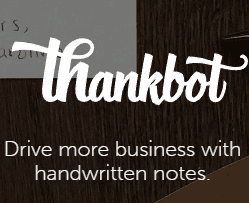How Thankbot Sold Fast: The Handwritten Notes Startup That Cashed In on Personal Touch

Business Description
Table of Contents
Navigate through the case study sections
Executive Summary
Case Study Content
Handwriting Profits: The Rapid Rise and Sale of Thankbot’s Personal Notes Startup
In an era where most people barely look up from their phones, getting something handwritten and personal in the mail feels like a little shock. That was the realization at the core of Thankbot: people and businesses want to stand out, and a digital message, even if exquisitely designed, just doesn’t have the same effect. Where everything from receipts to love letters turned digital, Thankbot’s handwritten notes, crafted by real humans, cut through the noise. Their fast sale on Flippa above reserve showed just how much true personalization still matters in a tech-driven world.
A Clear Problem: Digital Fatigue
We scroll. We tap. We skim. Email open rates drop, notifications pile up. Businesses looking to thank clients, nudge prospects, or surprise partners with something memorable, get ignored in the flood of email. Thankbot saw an opportunity others missed: nobody tosses a handwritten card in the trash unopened. Whether you’re a real estate agent, nonprofit, or SaaS founder, if you want a client or donor to remember you, a tangible piece of mail works better than bits and pixels.
How Thankbot Worked: Combining Tech with Real Handwriting
Thankbot’s service was all about simplicity and realness. Customers submitted their message using an online tool. The company’s team of writers, called "scribes, " wrote out every note by hand. If you wanted custom stationery with your own logo, you mailed it in and Thankbot used it directly. Cards were sent out in a few business days, never pre-printed, always real pen on paper. Pricing was transparent, with four packages based on quantity. Large businesses and individuals found value in a process that felt both new and time-tested.
Catching Attention: From Flippa Auction to Bidding War
Selling a business in a niche like handwritten notes could be tough if it didn’t show traction. But Thankbot had a secret weapon, its uniqueness. Flippa buyers, used to seeing sites offering SEO services or dropshipping gadgets, perked up at a real-world service mixing digital ease with authentic, offline engagement. The sale moved fast for several reasons:
- Well-priced to tempt immediate attention
- Niche with low direct competition
- Highly engaged Flippa audience: 704 views, 56 watchers
- Sold for $22,000, well above the undisclosed reserve (~4x higher)
- 19 competitive bids from 6 different bidders
- Active discussion and positive comments on the listing
The Flippa listing became a magnet: more people watched it than the majority of similar auctions, and spirited discussion built confidence for new buyers. The emotional lift of a small, human-centric brand was hard to ignore, especially right as automation in business communication reached its peak density.
Who Used Thankbot?
Two core audiences loved Thankbot: businesses wanting to nurture relationships (think: client celebrations, follow-ups, or apology notes) and individuals sending thanks that needed to truly land. Real estate brokers, creative agencies, recruitment firms, consultants, and anyone who sent bulk thank-you notes or invitations found the service time-saving. Smaller-scale users, parents, freelancers, small online store owners, would sign up for personal outreach that needed to feel "not mass-produced." People could even ship their own preferred stationery to achieve brand consistency.
Personalization at Scale: Why This Startup Succeeded
A lot of startups say they offer something "personal." Thankbot made it literal, no shortcuts. Actual pens on actual cards by real writers. No fancy printing and font tricks, the difference was obvious on first touch. The operational model relied on a workflow that balanced tech (online order management, customer data, CRM links) with low-overhead labor for fulfilling orders. They created unique value with real humans writing out what mattered, while keeping ordering as frictionless as a SaaS tool. The ability to use your own branding or personal touches helped close the authenticity loop.
Acquisition Details: Fast Sale, Fierce Competition
The sale on Flippa moved quicker than almost anyone expected. With an attractive reserve price, and features that stood out in a saturated services marketplace, Thankbot generated 19 bids and sold for $22,000. In total, the auction logged 704 views, 56 watchers, and a lively comment section that reassured bidders of the site’s traction and community appeal. The business had profit, engagement, and an operational system that was nearly turnkey for any buyer.
Growth Levers and Execution
- Clear, emotional value proposition, easy to articulate to both buyers and customers
- Modern online ordering, reduced friction for getting bulk handwritten notes
- Simple pricing tiers, no guesswork for buyers or customers
- Lean operations using contract writers meant scaling volume up or down without legacy staffing
- Authenticity, using your own stationery or letting Thankbot pick classic, high-quality cards
- Marketed via content, niche forums, and social media rather than mass advertising
Lessons and Takeaways For Entrepreneurs
Thankbot’s journey proved there’s still demand for "old-school" authenticity, particularly when you bolt it to digital convenience. A seemingly simple idea, real handwritten notes, made sendable with a couple of clicks, hit an emotional need modern SaaS tools can't reach. For founders, it’s a reminder to spot what’s missing (not just what’s automated), and that you don’t have to run a VC-funded rocketship to earn a profitable, sought-after exit. When digital fatigue sets in, the tactile, tangible becomes rare, and rare means valuable.
The Human Touch Isn't Dead Yet
Thankbot’s story is one of refusing to trade everything in for convenience. The world’s better with some things left slow and human-made, even if most of the business was fueled and marketed online. For anyone thinking about starting or selling a passion project, the numbers say it all: no-code tools and authenticity together can still win in a market crowded with automation. If you’re hunting for a model to copy, the handwritten route isn’t saturated, you just need a good story and operational discipline behind it.
Key Takeaways
- 1Standing out with a genuinely personal product, real handwritten notes, can outperform mass-automated digital services when the value and execution are real.
- 2Selling a business is easier with a unique, clearly stated value proposition that buyers can immediately understand and believe.
- 3Mixing tech for ordering and workflow with human labor for delivery allowed Thankbot to operate lean and flexible, avoiding overhead traps.
- 4Flippa works best for businesses with both traction and community engagement, as visible interest drives more buyers to bid competitively.
- 5Direct mail isn't dead, paired with online tools, it can increase response rates and customer retention for both individual and business clients.
- 6Low-cost, bootstrapped startups targeting overlooked real-world pains are still acquisition targets, even in crowded online service markets.
Tools & Technologies Used
Premium Content Locked
Subscribe to access the tools and technologies used in this case study.
Unlock NowHow to Replicate This Success
Premium Content Locked
Subscribe to access the step-by-step replication guide for this case study.
Unlock NowInterested in Being Featured?
Share your success story with our community of entrepreneurs.
Explore More Case Studies
Discover other inspiring business success stories

How BlockSurvey Reached $15K MRR in Web3 with Privacy-First Approach
Starting from a hackathon spark, BlockSurvey reinvented surveys with end-to-end encryption and blockchain identity. Toda...
BlockSurvey

How a 24-Year-Old Built a $50M Anonymous Messaging App from His Bedroom
In early 2021, college dropout Hunter Isaacson designed NGL as a simple, anonymous feedback tool. With just $10K and a f...
NGL

How Erik Cagi Earns $12K+/Month with Spanish Course Ads
Erik Cagi, a solo affiliate marketer, discovered a high-converting angle in the language niche with Synergy Spanish. By ...
ErikCagi